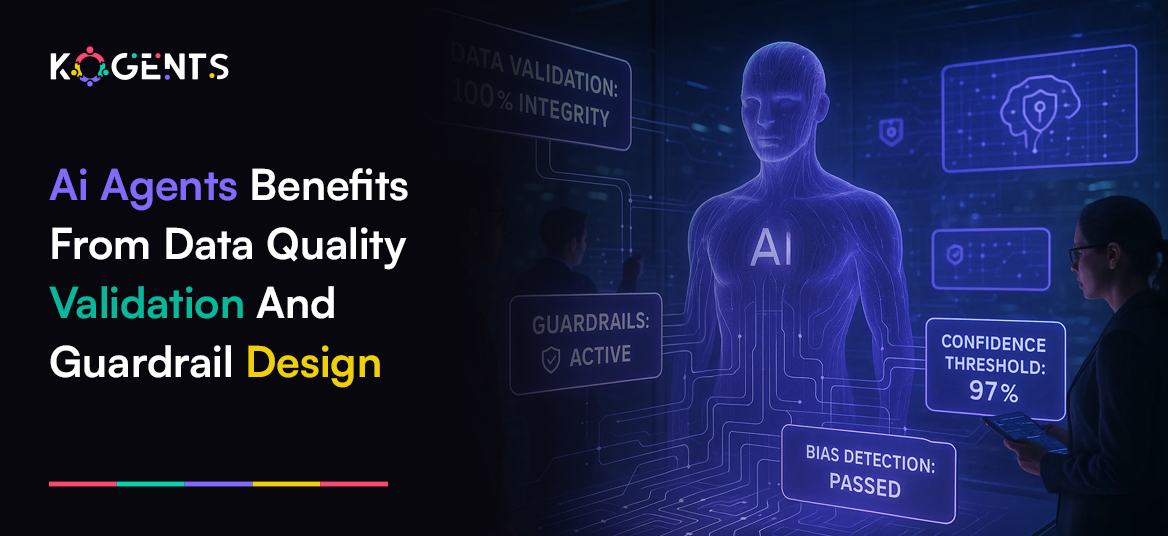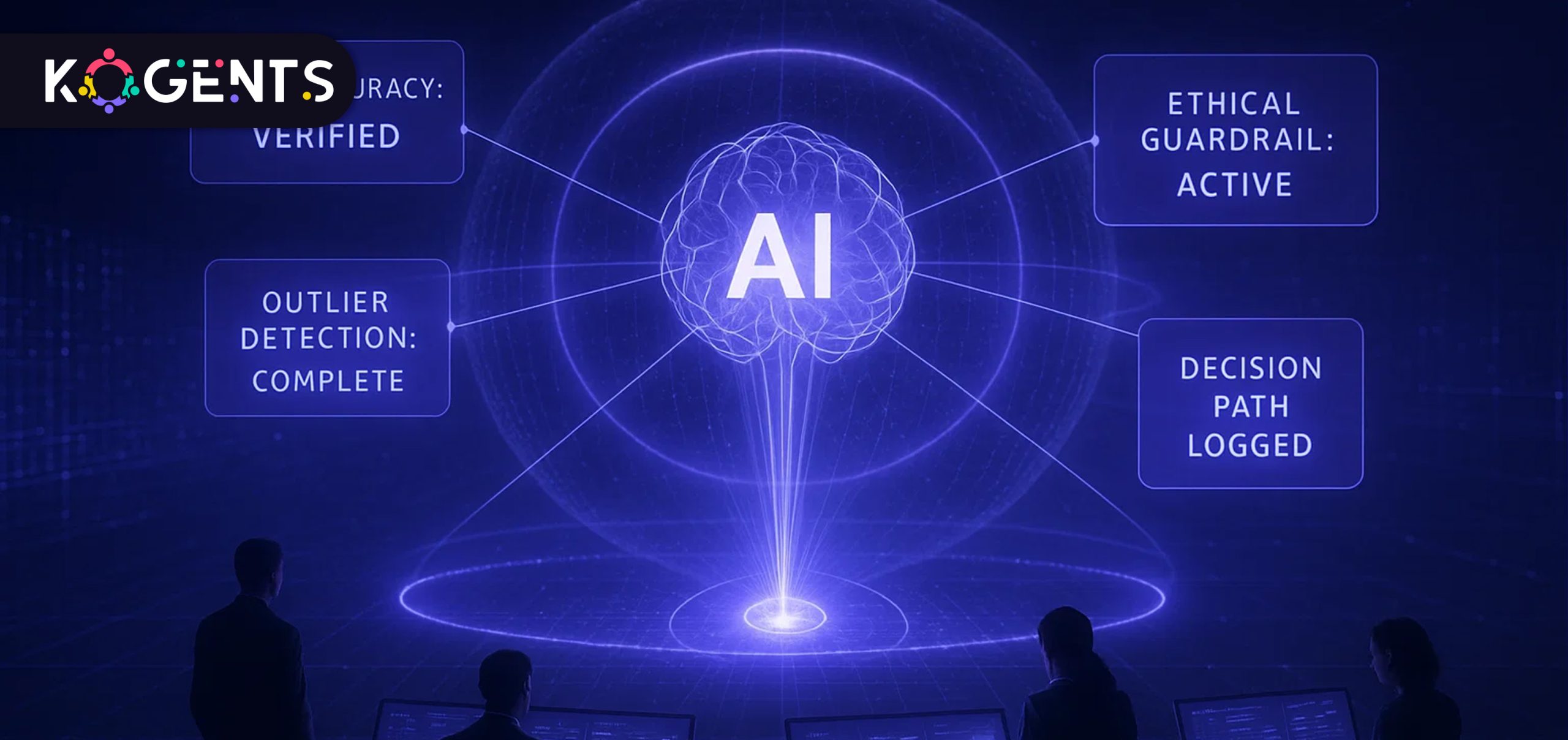AI Agents Benefit From Data Quality Validation And Guardrail Design

Summary:
Imagine launching a digital workforce of intelligent agents that operate on unreliable data or without boundaries.
Sounds risky, right?
Poor data quality translates into bad decisions, wasted effort, and trust erosion.
Equally, unregulated or misaligned agents may veer off course, produce biased outcomes, or violate policy.
The convergence of reliable data and thoughtful guardrails is what enables organisations to unlock the AI agent benefits, including productivity gains, cost savings, improved decision-making, and new business value.
In this post, we’ll explore how scalable AI solutions are offered by AI agents that are amplified when backed by rigorous data validation and robust guardrails.
We’ll define these concepts, dig into why they matter, and show you via case studies how leading enterprises are realizing business benefits of AI agents with the right foundation.
Key Takeaways
- High-calibre data is the fuel that powers AI agents; without it, the benefits (efficiency, accuracy, insight) degrade rapidly.
- Guardrails—covering alignment, compliance, accuracy, and ethics—are critical enablers of trust, scalability, and value realisation.
- Deploying agents with poor data or weak guardrails leads to “silent failures” and erodes the benefits of using intelligent agents in AI.
- Organisations that treat data validation and guardrail design as integral to their agent strategy are far more likely to capture the enterprise AI development agent benefits.
- For lasting impact, shift from pilot to production by designing agent workflows, validating data pipelines, embedding guardrails, measuring outcomes, and iterating.

What Are AI Agents & Why Their Benefits Matter?
In the broad sense, a software entity that perceives its environment, takes actions autonomously (or semi-autonomously) to achieve goals, and adapts over time qualifies as an intelligent software agent.
In the contemporary era of agentic AI, these agents often leverage large language models (LLMs), tool-use capabilities, workflow orchestration, and multi-agent cooperation.
However, it is important to remember that the promise of AI agents’ benefits for customer service, marketing/sales, operations, etc., will only be captured fully if two essential enablers are managed: data quality validation and guardrail design.
Why Data Quality Validation Is Fundamental for AI Agents?
When you deploy an AI agent, you are entrusting it to act autonomously. It will make decisions, trigger workflows, and perhaps engage clients or systems.
That means it needs to be grounded on reliable input data, trustworthy context, and well-defined rules.
If the data pipeline is flawed, the agent’s output suffers, reducing your ROI of AI agents.
- Data validation means ensuring that inputs, whether training data, context feeds, system logs, or external signals, meet standards: completeness, consistency, accuracy, timeliness, and relevance.
- It also means monitoring for data drift, distribution shifts, anomalies, or outliers that may degrade agent performance.
- In the case of agents interacting in production, real-time data observability and lineage matter: one must know what data the agent used, how it got there, and whether it is still valid.
Why is this so critical for unlocking the value of AI agents?
- Accuracy of decisions: If an agent bases its decisions on stale, inconsistent, or biased data, outcomes will be flawed.
- Trust and reliability: Stakeholders need to trust that the agent’s actions are based on good information, and bad data erodes that trust quickly.
- Scalability: When you scale agents across many workflows, the data-validation overhead compounds. Without robust pipelines, you risk systemic failure.
- Regulatory and compliance risk: If your agent acts on faulty data, you may face legal and reputation risk.
- Full benefits realisation: The spectrum of benefits, efficiency, automation, and deeper insight can only be achieved if the agents consistently operate on high-quality data.
What does good practice look like?
- Define data quality metrics and thresholds: completeness, uniqueness, freshness, consistency.
- Build validation guardrails within your data pipelines.
- Monitor data lineage and impact: know which datasets feed which agents, and the downstream effects of any change.
- Use agent observability to track data input flows and flag unusual patterns.
Example: Monte Carlo Data highlights that AI agent evaluation is deeply linked to data + AI observability
- Ensure your training, fine-tuning, and operational datasets are representative, curated, and maintained over time.
Guardrail Design: The Safety Net for Agentic AI Systems
If data validation is about the “what”, then guardrails are about the “how” and “why” (how the agent acts, why it stays within boundaries).
When you deploy autonomous AI agents, you need both technical and governance guardrails to ensure safe, trustworthy, aligned behaviour.
What are Guardrails?
According to McKinsey & Company, “AI guardrails help ensure that an organisation’s AI tools … reflect the organisation’s standards, policies and values.”
They describe types of guardrails such as appropriateness (filtering toxic/harmful content), hallucination, alignment, regulatory compliance, and validation.
Another vendor, Agno, describes pre-hooks (input checks), in-process guardrails, and post-hooks (output validation) for agents.
Why are Guardrails essential for realising the business benefits of AI agents?
- Mitigate risk: Agents acting without guardrails may hallucinate, escalate incorrectly, or violate compliance. Guardrails reduce the potential for catastrophic outcomes.
- Enable trust: Stakeholders are more willing to rely on agents when they know there are safety and policy controls in place.
- Scale with confidence: When agents cross organisational boundaries, integrate with systems, and make decisions, they need boundaries so you can scale reliably.
- Unlock full operations: Without guardrails, you may be limited to low-risk assistant setups. With guardrails in place, you can deploy agents to higher-value, higher-autonomy workflows.
Key guardrail types to design for agentic systems
- Input validation guardrails (pre-execution): Reject or sanitize poor inputs, detect prompt injections, and block unauthorized APIs.
- In-process guardrails: Monitor decision paths, check for correct tool usage, and maintain alignment with business goals.
- Output validation guardrails (post-execution): Verify content meets quality, brand tone, compliance, and check for bias/hallucinations.
- Ongoing monitoring & observability: Track agent behaviour, drift, anomalies, and emergent risk.
- Governance and escalation: Human-in-the-loop review for high-stakes actions, audit trails, and escalation paths.
How guardrails amplify the value of AI agents?
When you layer robust guardrails, you move from “assistant”-level benefit to true empowerment: end-to-end autonomous workflows, decision support, cost avoidance, risk mitigation.
This translates into larger ROI, faster scale, and deeper enterprise AI agent benefits.

How Data Validation + Guardrails Multiply the Benefits of AI Agents?
Having covered the individual pillars, let’s focus on how together they unlock the richer spectrum of benefits.
Efficiency and Productivity Gains
- With validated data feeding the agent, actions are correct and efficient; with guardrails in place, errors and retries are reduced.
- Agents can execute tasks confidently, freeing human effort for higher-value work — a strong component of productivity gains from AI agents.
Cost Savings & Operational Excellence
- Clean data means fewer failure costs, fewer human corrections. Guardrails prevent costly misactions or compliance breaches.
- Savings emerge in quality, error reduction, and time-to-value.
Trust, Compliance & Risk Mitigation
- Agents operating in regulated domains (finance, healthcare, supply chain) need to behave safely.
- Guardrails ensure alignment with laws and policies.
- Data validation guards against bias, inaccurate inputs, or downstream harm.
Note: Together, they enable trustworthy automation that unlocks bigger use cases and higher value.
Strategic Value & New Business Models
- When agents operate reliably across core workflows, organisations can reengineer processes, create new capabilities, and capture more strategic value, going beyond incremental automation to transformation.
Measuring & Scaling ROI
- Because data and guardrails underpin agent reliability, measurement of benefits becomes more straightforward: you can set baselines, track metrics (process time, error rates, cost per task), and scale with confidence.
Case Studies
Case Study 1: Financial Expense Processing with Automation Agent
In the paper titled “E2E Process Automation Leveraging Generative AI and IDP-Based Automation Agent” (Company S, Korea), the researchers integrated generative AI, intelligent document processing, and an Automation Agent to handle corporate expense tasks.
Outcome: over 80% reduction in processing time, decreased error rates, improved compliance, and increased employee satisfaction.
Why this matters: Here, the “agent” was empowered by clean data pipelines and human-in-the-loop guardrails for exceptions.
The strong data preparation and governance of exceptions enabled the full benefit of the agent.
Case Study 2: Google Cloud Report – ROI of AI Agents
In the “ROI of AI: How agents are delivering for business” report (Google Cloud, 2025), the findings included: 74% of execs achieved ROI within the first year; 39% of those organisations deployed more than 10 agents; among those reporting productivity gains, 39% saw productivity at least double.
Why this matters: Whilst not a micro-case of a single company, it provides aggregated evidence that when organisations deploy agents in production, they capture meaningful benefits of AI agents.
Comparison of Benefits Enabled by Data-Validation vs Guardrails
| Benefit Category | Enabled by Data Quality Validation | Enabled by Guardrails |
| Accuracy & Decision Integrity | Ensures inputs are reliable; prevents garbage-in | Ensures outputs and actions are aligned and safe |
| Productivity & Speed | Eliminates re-work due to bad data | Reduces delays from human escalation or error handling |
| Cost Savings | Fewer manual corrections, fewer data-related issues | Fewer risk events, fewer compliance or reputation losses |
| Trust & Adoption | Stakeholders trust the agent’s decisions | Stakeholders trust safe, predictable agent behaviour |
| Scalability & Automation | Data pipelines support scale | Guardrails provide governance, enabling broader deployment |
| Strategic Value & Innovation | Clean data enables insight & advanced workflows | Safe agent behaviour allows high-value use cases |
Conclusion
In summary, the benefits of AI agents are real and compelling, from productivity boosts, cost savings, and workflow automation to richer decision-making, customer experience improvement, and strategic transformation.
Yet, to unlock this full promise, organisations must look beyond the “coolness” of autonomous agents and invest in the often-less glamorous but critical foundations: data quality validation and guardrail design.
Think of this as building a high-performance race car: agents are the engine, data quality is the fuel, and guardrails are the safety systems.
At Kogents ai, we specialise in helping organisations design, deploy, and scale agentic AI ecosystems powered by trusted data flows and governance-first architectures.
So, if you’re ready to move beyond the AI pilot phase and capture the enterprise AI agents’ benefits at scale, with the best agentic AI company like us, then reach out to us.
FAQs
What is the difference between data quality validation and guardrail design when deploying AI agents?
Data quality validation focuses on ensuring the inputs (data) that feed the agent are accurate, consistent, timely, and relevant. Without good data, even a well-designed agent will produce weak outcomes. Guardrail design, by contrast, is about governing the agent’s actions, ensuring it aligns with organisational values, avoids risk, operates within rules, and its outputs are safe and reliable. Together, they form two pillars of agentic deployment.
What types of guardrails should be in place when deploying autonomous agents?
Key guardrail types include: input-validation, in-process monitoring, output-validation, human-escalation thresholds, and audit logs. Some guardrails may involve alignment (brand voice, ethics), regulatory compliance (GDPR, HIPAA), and validation.
Is it possible to deploy AI agents without focusing on data quality and guardrails and still see benefits?
You might see some benefits in limited, low-risk scenarios, but you will likely plateau quickly. Without strong foundations, you expose yourself to risk, high maintenance costs, and sub-optimal outcomes. If you aim for full automation and scalability, these foundations are essential.
How should organisations prioritise data validation and guardrail investments when budgeting for agentic AI?
You should treat them as part of the agent deployment roadmap, not optional add-ons. Start allocating a budget for data-pipeline quality tools and guardrail design. Prioritise workflows with existing data maturity and lower risk, build the foundations, then expand to higher-value, higher-risk use cases. The incremental cost invested here will multiply the benefits of AI agents and amplify ROI.

Kogents AI builds intelligent agents for healthcare, education, and enterprises, delivering secure, scalable solutions that streamline workflows and boost efficiency.